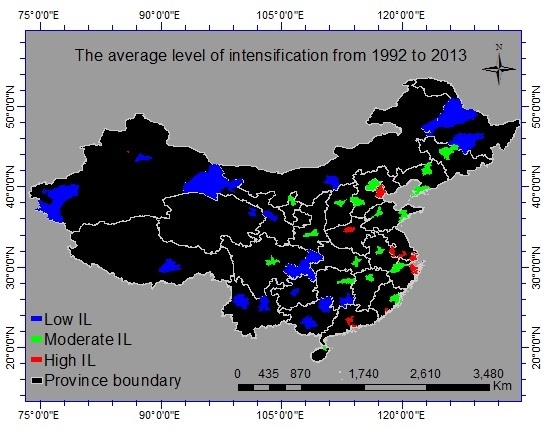Characterizing the Growth Patterns of 45 Major Metropolitans in Mainland China Using DMSP/OLS Data
Abstract
:1. Introduction
2. Nighttime Light Data and the Methodologies
2.1. DMSP/OLS Data Description
2.2. DMSP/OLS Data Preprocessing
2.3. Selecting Major Metropolitans in Mainland China
2.4. Measuring Metropolitan Growth with Intensification and Expansion
3. Results
3.1. Growth Patterns from Intensification
3.2. Growth Patterns from Expansion
3.3. Relationship between Intensification and Expansion for Each Metropolitan
4. Discussion and Limitations
4.1. On Growth Patterns in Terms of Intensification and Expansion
4.2. On Socio-Economic Correlation with IL and EL in Each Year
4.3. Limitations
5. Conclusions
Acknowledgments
Author Contributions
Conflicts of Interest
References
- United Nations. World Urbanization Prospects: The 2014 Revision; United Nations Population Division: New York, NY, USA, 2014. [Google Scholar]
- Frey, W. Will This Be the Decade of Big City Growth? The Brookings Institution: Washington, DC, USA, 2014. [Google Scholar]
- Song, X.P.; Sexton, J.O.; Huang, C.; Channan, S.; Townshend, J.R. Characterizing the magnitude, timing and duration of urban growth from time series of Landsat-based estimates of impervious cover. Remote Sens. Environ. 2016, 175, 1–13. [Google Scholar] [CrossRef]
- Zhang, Q.; Su, S.L. Determinants of urban expansion and their relative importance: A comparative analysis of 30 major metropolitans in China. Habitat Int. 2016, 58, 89–107. [Google Scholar] [CrossRef]
- Yu, B.; Shu, S.; Liu, H.; Song, W.; Wu, J.; Wang, L.; Chen, Z. Object-based spatial cluster analysis of urban landscape pattern using nighttime light satellite images: A case study of China. Int. J. Geogr. Inf. Sci. 2014, 28, 2328–2355. [Google Scholar] [CrossRef]
- Marull, J.; Font, C.; Boix, R. Modelling urban networks at mega-regional scale: Are increasingly complex urban systems sustainable? Land Use Policy 2015, 43, 15–27. [Google Scholar] [CrossRef]
- Pacione, M. Urban Geography—A Global Perspective; Routledge: London, UK, 2009. [Google Scholar]
- Salvati, L.; Venanzoni, G.; Serra, P.; Carlucci, M. Scattered or polycentric? Untangling urban growth in hree southern European metropolitan regions through exploratory spatial data analysis. Ann. Reg. Sci. 2016, 57, 1–29. [Google Scholar] [CrossRef]
- Han, L.; Zhou, W.; Li, W.; Li, L. Impact of urbanization level on urban air quality: A case of fine particles (PM2.5) in Chinese cities. Environ. Pollut. 2014, 194, 163–170. [Google Scholar] [CrossRef] [PubMed]
- Shi, K.; Chen, Y.; Yu, B.; Xu, T.; Li, L.; Huang, C.; Liu, R.; Chen, Z.; Wu, J. Urban expansion and agricultural land loss in China: A multiscale perspective. Sustainability 2016, 8, 790. [Google Scholar] [CrossRef]
- Fverboven, H.; Uyttenbroeck, R.; Brys, R.; Hermy, M. Different responses of bees and hoverflies to land use in an urban-rural gradient show the importance of the nature of the rural land use. Landsc. Urban Plan. 2014, 126, 31–41. [Google Scholar] [CrossRef]
- Liu, Y.; Wang, Y.; Peng, J.; Du, Y.; Liu, X.; Li, S.; Zhang, D. Correlations between urbanization and vegetation degradation across the world’s metropolises using DMSP/OLS nighttime light data. Remote Sens. 2015, 7, 2067–2088. [Google Scholar] [CrossRef]
- Vramachandra, T.; Haithal, B.; Durgappasanna, D. Insights to urban dynamics through landscape spatial pattern analysis. Int. J. Appl. Earth Obs. Geoinf. 2012, 18, 329–343. [Google Scholar]
- Ghosh, T.; Anderson, S.; Elvidge, C.D.; Sutton, P.C. Using nighttime satellite imagery as a proxy measure of human well-being. Sustainability 2013, 5, 4988–5019. [Google Scholar] [CrossRef]
- Small, C.; Elvidge, C.D. Night on Earth: Mapping decadal changes of anthropogenic night light in Asia. Int. J. Appl. Earth Obs. Geoinf. 2013, 22, 40–52. [Google Scholar] [CrossRef]
- Sutton, P.; Roberts, D.; Elvidge, C.; Baugh, K. Census from Heaven: An estimate of the global human population using night-time satellite imagery. Int. J. Remote Sens. 2001, 22, 3061–3076. [Google Scholar] [CrossRef]
- Elvidge, C.D.; Tuttle, B.T.; Sutton, P.C.; Baugh, K.E.; Howard, A.T.; Milesi, C.; Bhaduri, B.L.; Nemani, R. Global distribution and density of constructed impervious surfaces. Sensors 2007, 7, 1962–1979. [Google Scholar] [CrossRef]
- Chen, Z.; Yu, B.; Hu, Y.; Huang, C.; Shi, K.; Wu, J. Estimating house vacancy rate in metropolitan areas using NPP-VIIRS nighttime light composite data. IEEE J. Sel. Top. Appl. Earth Obs. Remote Sens. 2015, 8, 2188–2197. [Google Scholar] [CrossRef]
- Sutton, P.C.; Costanza, R. Global estimates of market and non-market values derived from nighttime satellite imagery, land cover, and ecosystem service valuation. Ecol. Econ. 2002, 41, 509–527. [Google Scholar] [CrossRef]
- Doll, C.N.H.; Muller, J.-P.; Morley, J.G. Mapping regional economic activity from night-time light satellite imagery. Ecol. Econ. 2006, 57, 75–92. [Google Scholar] [CrossRef]
- Ghosh, T.; Powell, R.L.; Anderson, S.; Sutton, P.C.; Elvidge, C.D. Informal economy and remittance estimates of India using nighttime imagery. Int. J. Ecol. Econ. Stat. 2010, 17, 16–50. [Google Scholar]
- Forbes, D.J. Multi-scale analysis of the relationship between economic statistics and DMSP-OLS night light images. GISci. Remote Sens. 2013, 50, 483–499. [Google Scholar]
- Shi, K.; Yu, B.; Huang, Y.; Hu, Y.; Yin, B.; Chen, Z.; Chen, L.; Wu, J. Evaluating the ability of NPP-VIIRS nighttime light data to estimate the gross domestic product and the electric power consumption of China at multiple scales: A comparison with DMSP-OLS data. Remote Sens. 2014, 6, 1705–1724. [Google Scholar] [CrossRef]
- Zhang, Q.; Seto, K.C. Mapping urbanization dynamics at regional and global scales using multi-temporal DMSP/OLS nighttime light data. Remote Sens. Environ. 2011, 115, 2320–2329. [Google Scholar] [CrossRef]
- Ma, T.; Zhou, C.; Pei, T.; Haynie, S.; Fan, J. Quantitative estimation of urbanization dynamics using time series of DMSP/OLS nighttime light data: A comparative case study from China’s cities. Remote Sens. Environ. 2012, 124, 99–107. [Google Scholar] [CrossRef]
- Xu, T.; Ma, T.; Zhou, C.; Zhou, Y. Characterizing spatio-temporal dynamics of urbanization in China using time series of DMSP/OLS night light data. Remote Sens. 2014, 6, 7708–7731. [Google Scholar] [CrossRef]
- Gao, B.; Huang, Q.; He, C.; Ma, Q. Dynamics of urbanization levels in China from 1992 to 2012: Perspective from DMSP/OLS nighttime light data. Remote Sens. 2015, 7, 1721–1735. [Google Scholar] [CrossRef]
- Ma, T.; Yin, Z.; Li, B.; Zhou, C.; Haynie, S. Quantitative estimation of the velocity of urbanization in China using nighttime luminosity data. Remote Sens. 2016, 8, 94. [Google Scholar] [CrossRef]
- Seto, K.C.; Fragkias, M.; Güneralp, B.; Reilly, M.K. A meta-analysis of global urban land expansion. PLoS ONE 2011, 6, e23777. [Google Scholar] [CrossRef] [PubMed]
- Liu, Z.; He, C.; Zhang, Q.; Huang, Q.; Yang, Y. Extracting the dynamics of urban expansion in China using DMSP-OLS nighttime light data from 1992 to 2008. Landsc. Urban Plan. 2012, 106, 62–72. [Google Scholar] [CrossRef]
- Gao, B.; Huang, Q.; He, C.; Sun, Z.; Zhang, D. How does sprawl differ across cities in China? A multi-scale investigation using nighttime light and census data. Landsc. Urban Plan. 2016, 148, 89–98. [Google Scholar] [CrossRef]
- Wei, Y.; Liu, H.; Song, W.; Yu, B.; Xiu, C. Normalization of time series DMSP-OLS nighttime light images for urban growth analysis with Pseudo Invariant Features. Landsc. Urban Plan. 2014, 128, 1–13. [Google Scholar] [CrossRef]
- Peter, C.; Nicola, P.; Didier, S. Dynamics and spatial distribution of global nighttime lights. EPJ Data Sci. 2014, 3, 1–26. [Google Scholar]
- Wu, W.; Zhao, S.; Zhu, C.; Jiang, J. A comparative study of urban expansion in Beijing, Tianjin and Shijiazhuang over the past three decades. Landsc. Urban Plan. 2015, 134, 93–106. [Google Scholar] [CrossRef]
- You, H. Quantifying megacity growth in response to economic transition: A case of Shanghai, China. Habitat Int. 2016, 53, 115–122. [Google Scholar] [CrossRef]
- Haas, J.; Ban, Y. Urban growth and environmental impacts in Jing-Jin-Ji, the Yangtze River Delta and the Pearl River Delta. Int. J. Appl. Earth Obs. Geoinf. 2014, 30, 42–55. [Google Scholar] [CrossRef]
- Ma, Q.; He, C.; Wu, J.; Liu, Z.; Zhang, Q.; Sun, Z. Quantifying spatiotemporal patterns of urban impervious surfaces in China: An improved assessment using nighttime light data. Landsc. Urban Plan. 2014, 130, 36–49. [Google Scholar] [CrossRef]
- Liu, Z.; He, C.; Wu, J. General spatiotemporal patterns of urbanization: An examination of 16 World Cities. Sustainability 2016, 8, 41. [Google Scholar] [CrossRef]
- Vogel, R.K.; Savitch, H.V.; Xu, J.; Yeh, A.G.O.; Wu, W.; Sancton, A.; Kantor, P.; Newman, P.; Tsukamoto, T.; Cheung, P.T.Y.; et al. Governing global city regions in China and the West. Prog. Plan. 2010, 73, 1–75. [Google Scholar] [CrossRef]
- Chen, M.; Liu, W.; Lu, D. Challenges and the way forward in China’s new type urbanization. Land Use Policy 2016, 55, 334–339. [Google Scholar] [CrossRef]
- Elvidge, C.D.; Baugh, K.E.; Kihn, E.A.; Kroehl, H.W.; Davis, E.R. Mapping city lights with nighttime data from the DMSP operational linescan system. Photogram. Eng. Remote Sens. 1997, 63, 727–734. [Google Scholar]
- Baugh, K.E.; Elvidge, C.D.; Ghosh, T.; Ziskin, D. Development of a 2009 stable lights product using DMSP-OLS data. In Proceedings of the 30th Asia-Pacific Advanced Network Meeting, Sydney, Australia, 7–11 February 2010. [Google Scholar]
- Elvidge, C.D.; Ziskin, D.; Baugh, K.E.; Tuttle, B.T.; Ghosh, T.; Pack, D.W.; Erwin, E.H.; Zhizhin, M. Fifteen year record of global natural gas flaring derived from satellite data. Energies 2009, 2, 595–622. [Google Scholar] [CrossRef]
- Strano, E.; Nicosia, V.; Latora, V.; Porta, S.; Barthelemy, M. Elementary processes governing the evolution of road networks. Sci. Rep. 2012, 2, 1–8. [Google Scholar] [CrossRef] [PubMed]
- Jia, T.; Qin, K.; Shan, J. An exploratory analysis on the evolution of the US airport network. Physica A 2014, 413, 266–279. [Google Scholar] [CrossRef]
- Lo, A.W.; MacKinlay, A.C. The Size and Power of the Variance Ratio Test. J. Econ. 1989, 40, 203–238. [Google Scholar] [CrossRef]
- Pandey, B.; Joshi, P.K.; Seto, K.C. Monitoring urbanization dynamics in India using DMSP/OLS night time lights and SPOT-VGT data. Int. J. Appl. Earth Obs. Geoinf. 2013, 23, 49–61. [Google Scholar] [CrossRef]
- Elvidge, C.D.; Baugh, K.E.; Kihn, E.A.; Kroehl, H.W.; Davis, E.R.; Davis, C.W. Relation between satellites observed visible—Near infrared emissions, population, economic activity and electric power consumption. Int. J. Remote Sens. 1997, 18, 1373–1379. [Google Scholar] [CrossRef]
- Ebener, S.; Murray, C.; Tandon, A.; Elvidge, C.C. From wealth to health: Modeling the distribution of income per capita at the sub-national level using night-time light imagery. Int. J. Health Geogr. 2005, 4, 5–14. [Google Scholar] [CrossRef] [PubMed]
- Zhang, Q.; Pandey, B.; Seto, K.C. A robust method to generate a consistent time series from DMSP/OLS nighttime light data. IEEE Trans. Geosci. Remote Sens. 2016, 54, 5821–5831. [Google Scholar] [CrossRef]
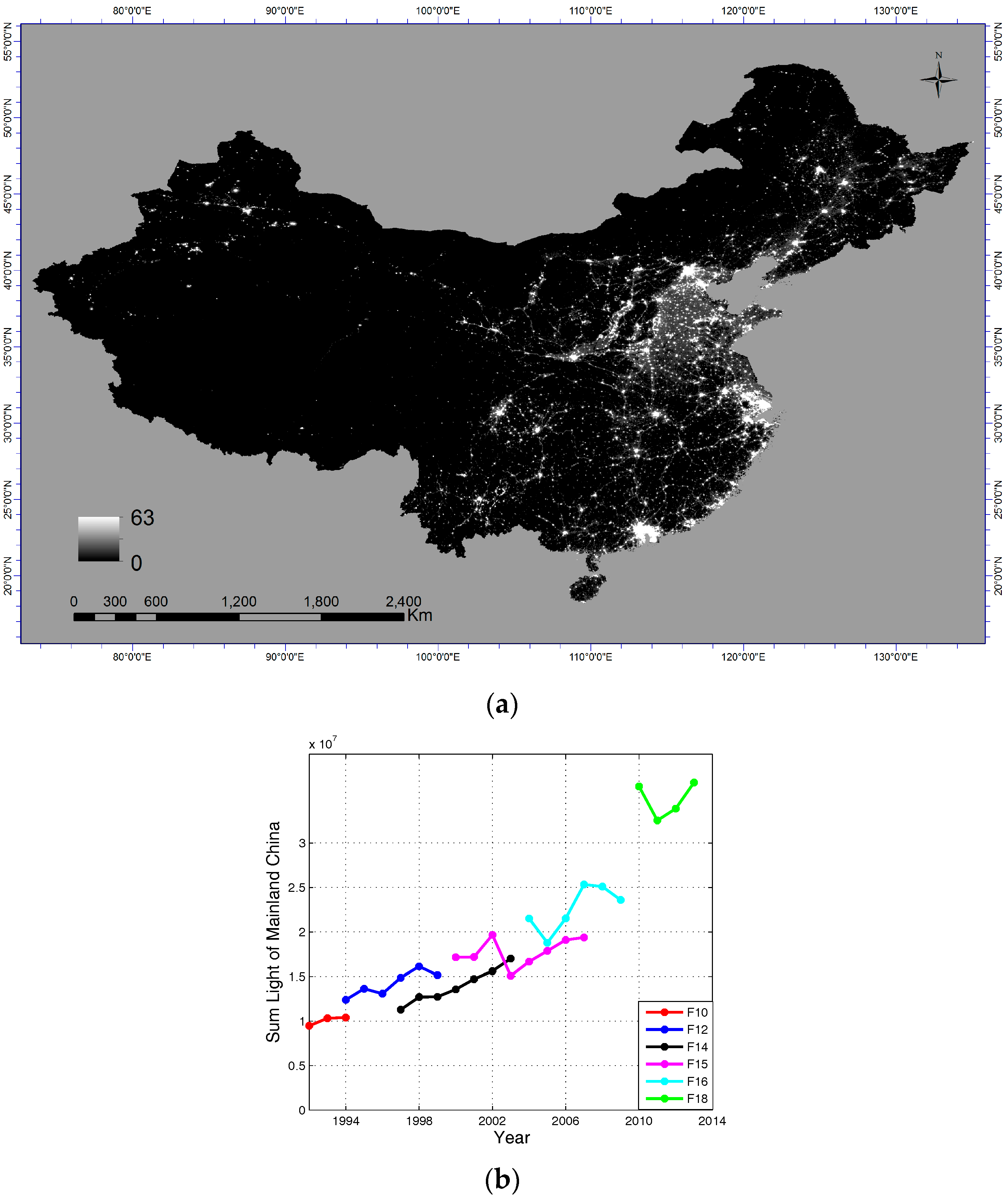
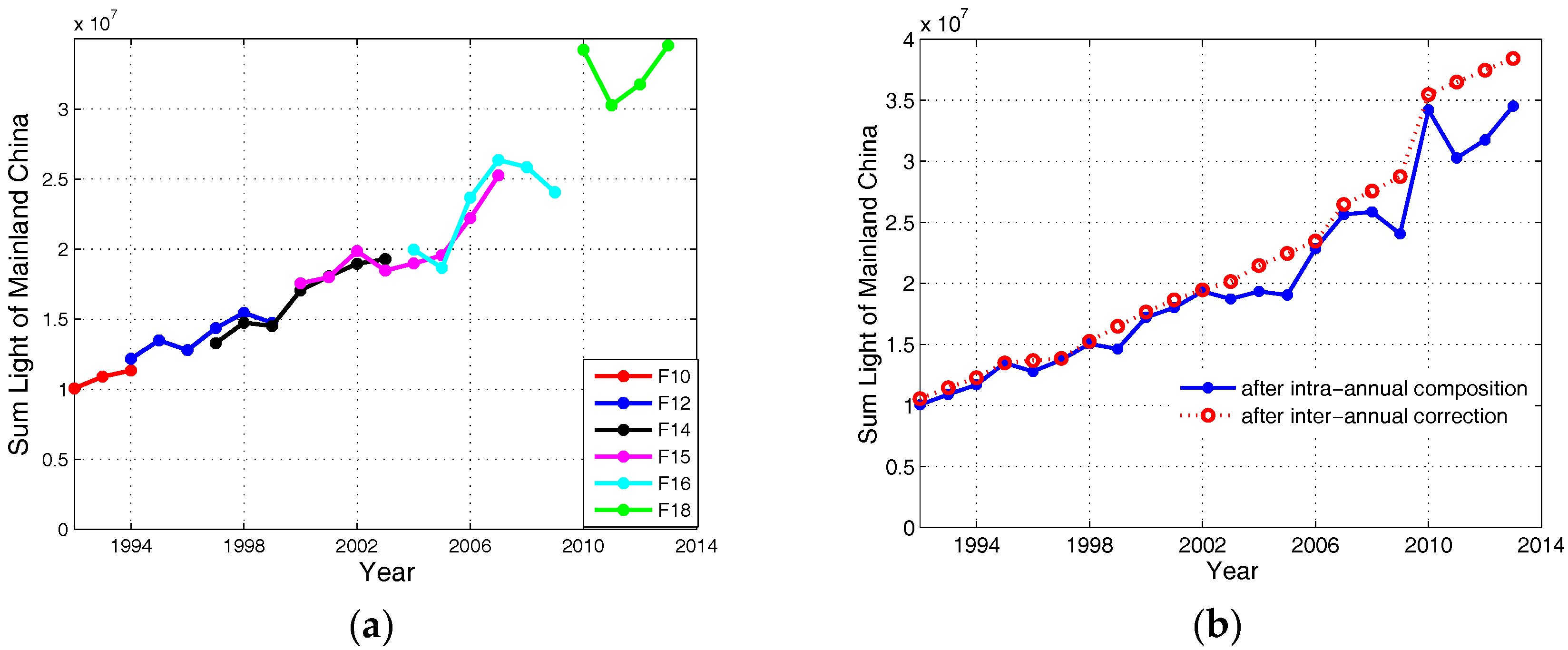


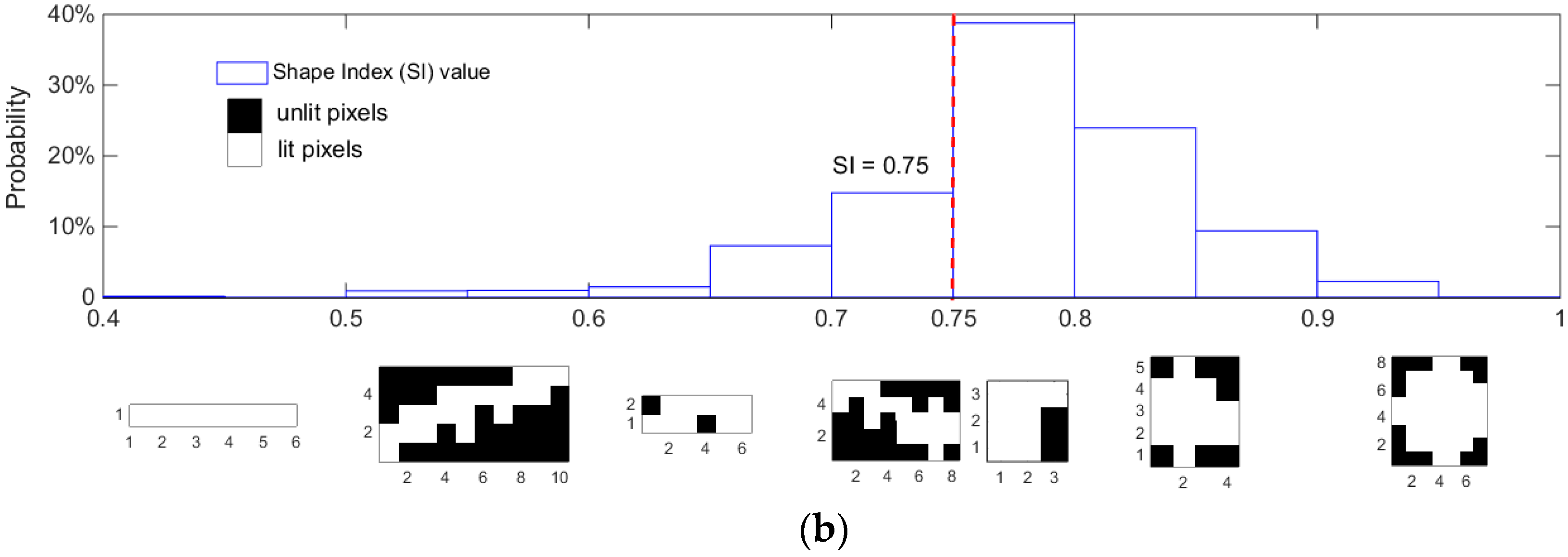
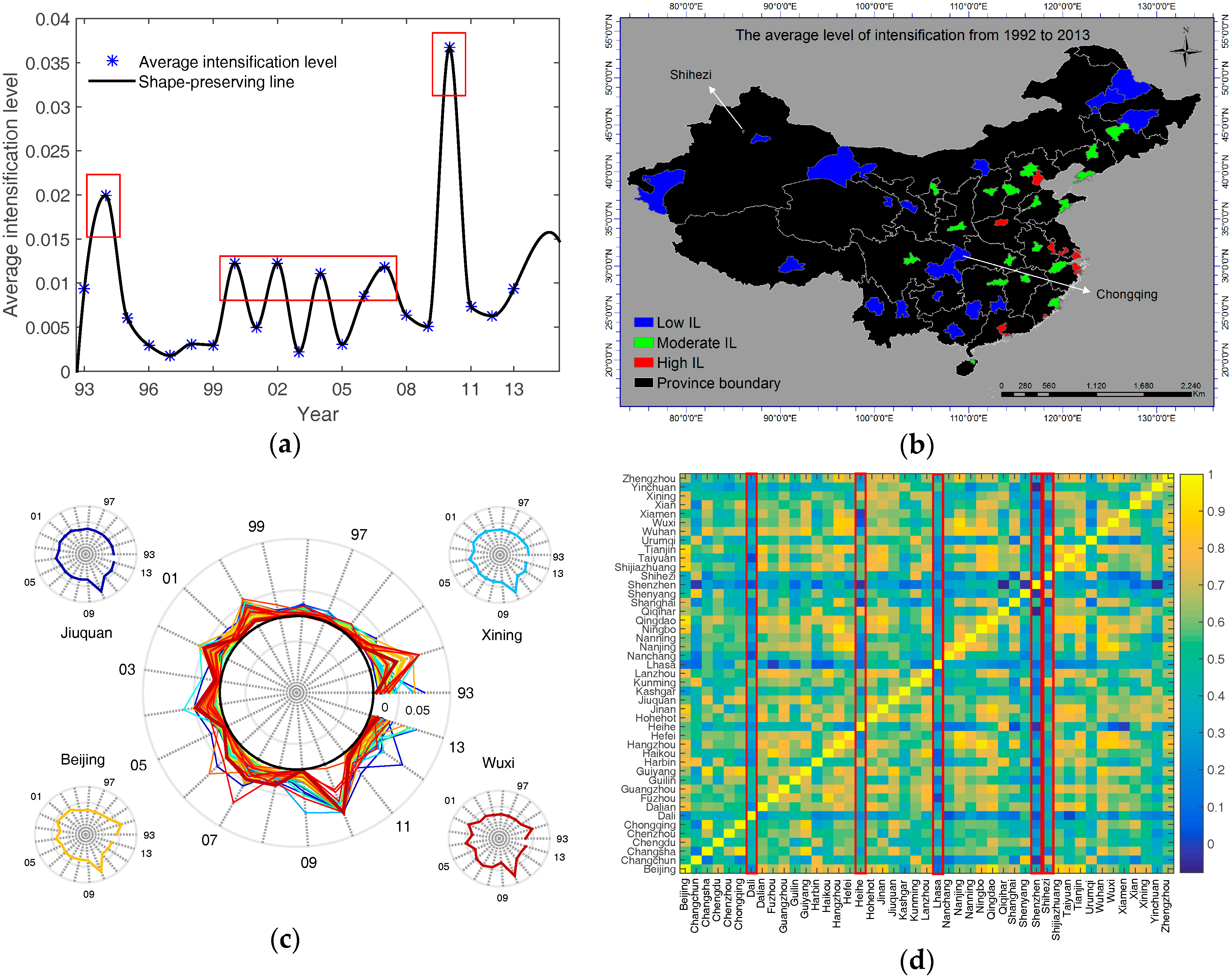
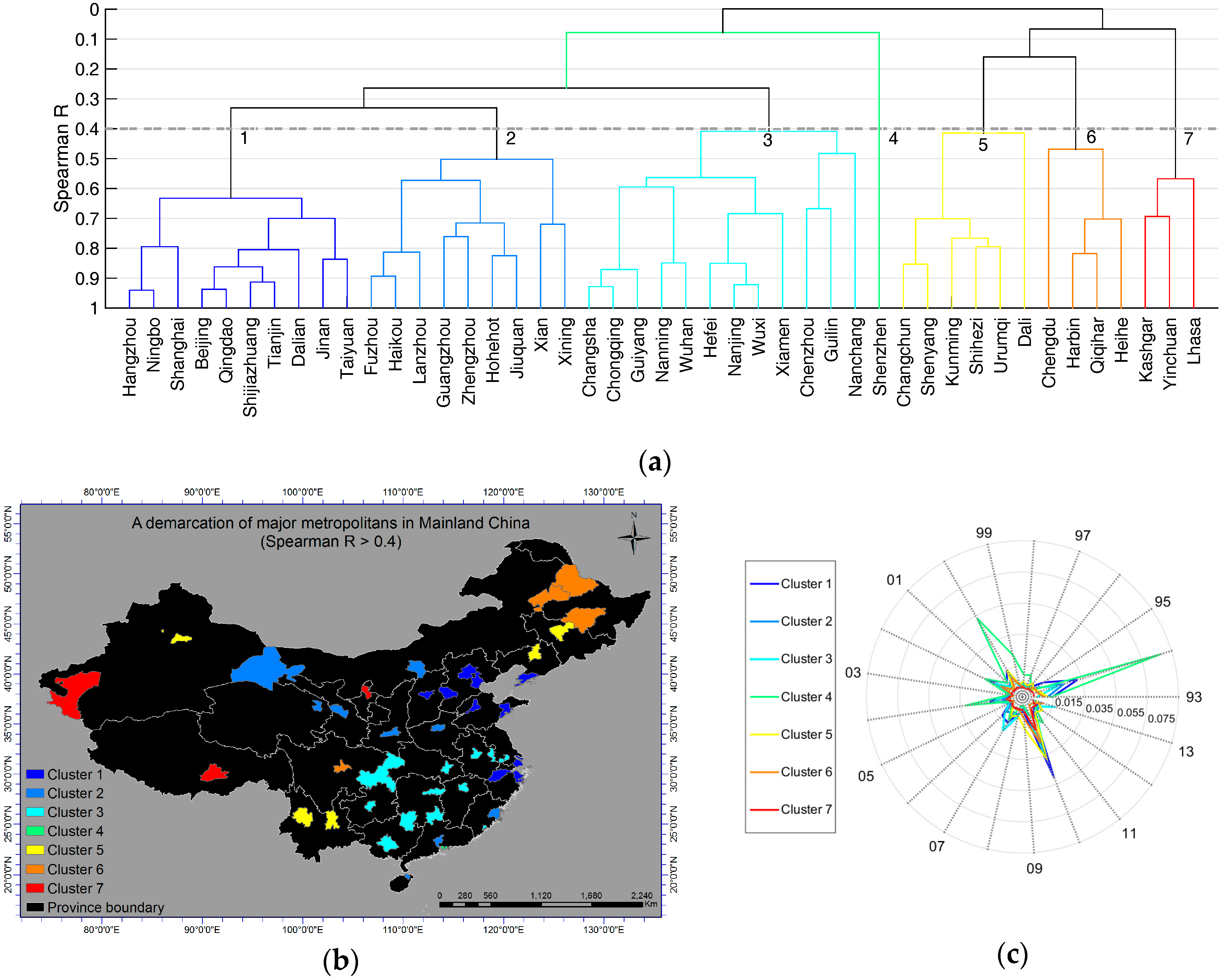
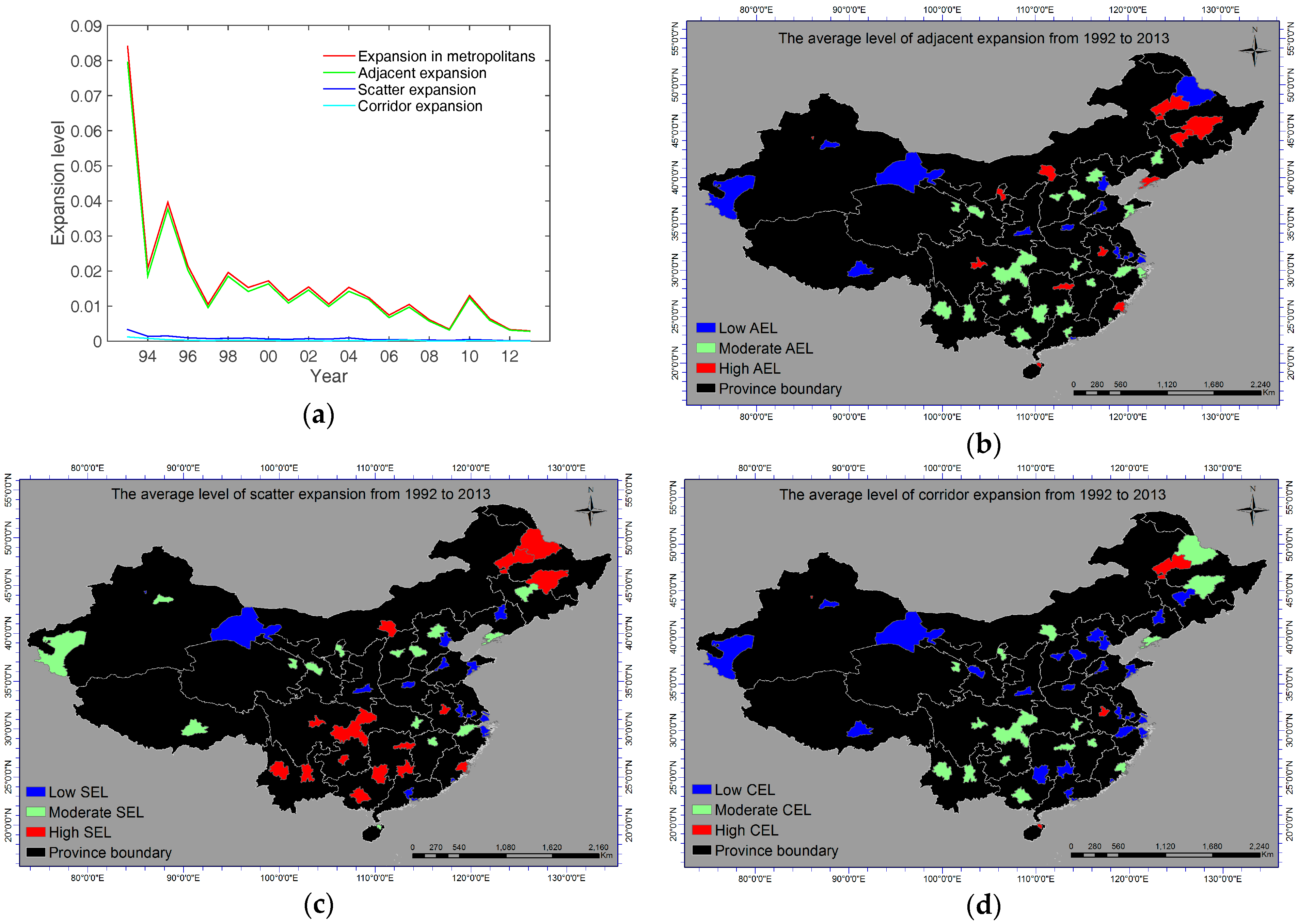
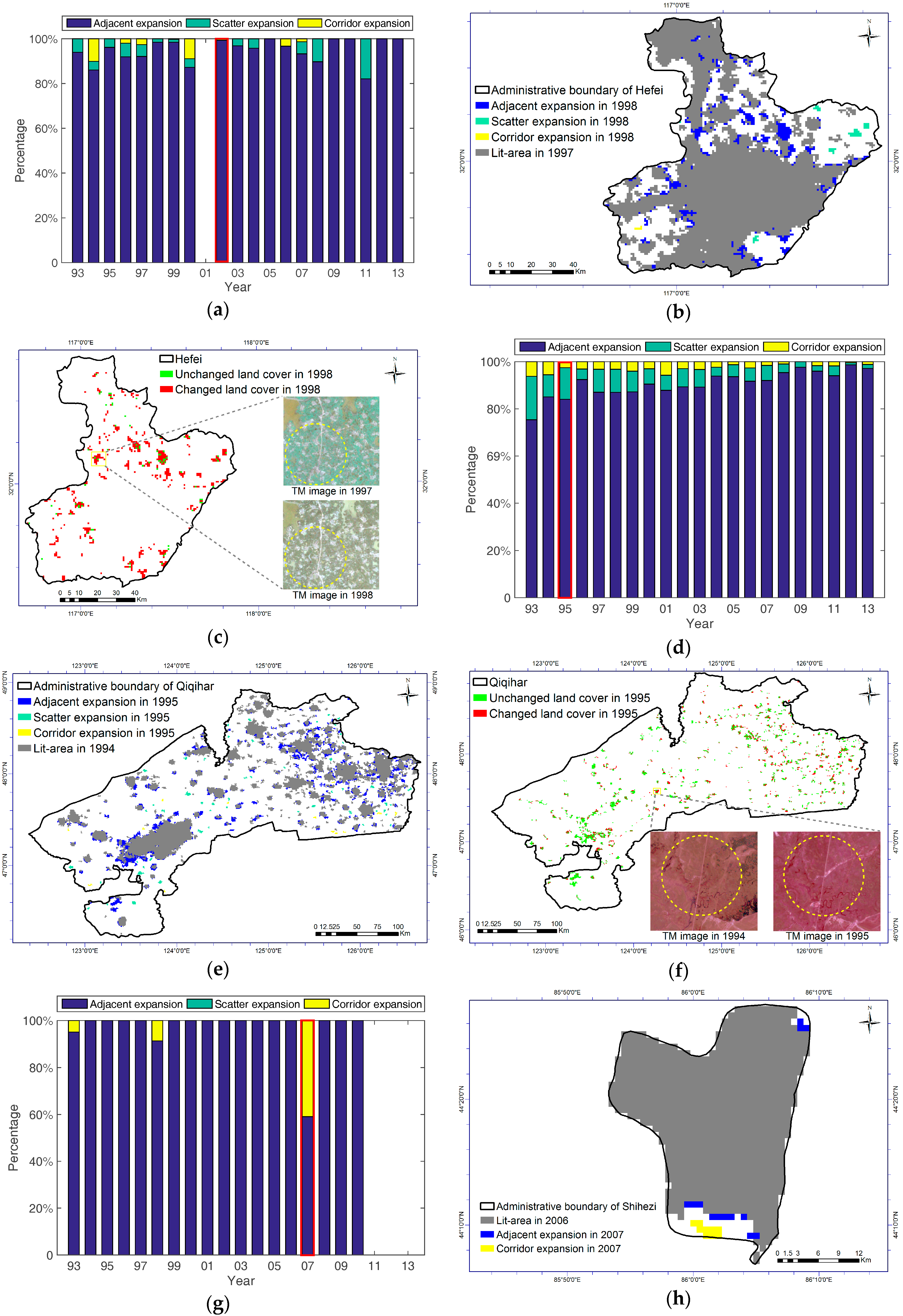
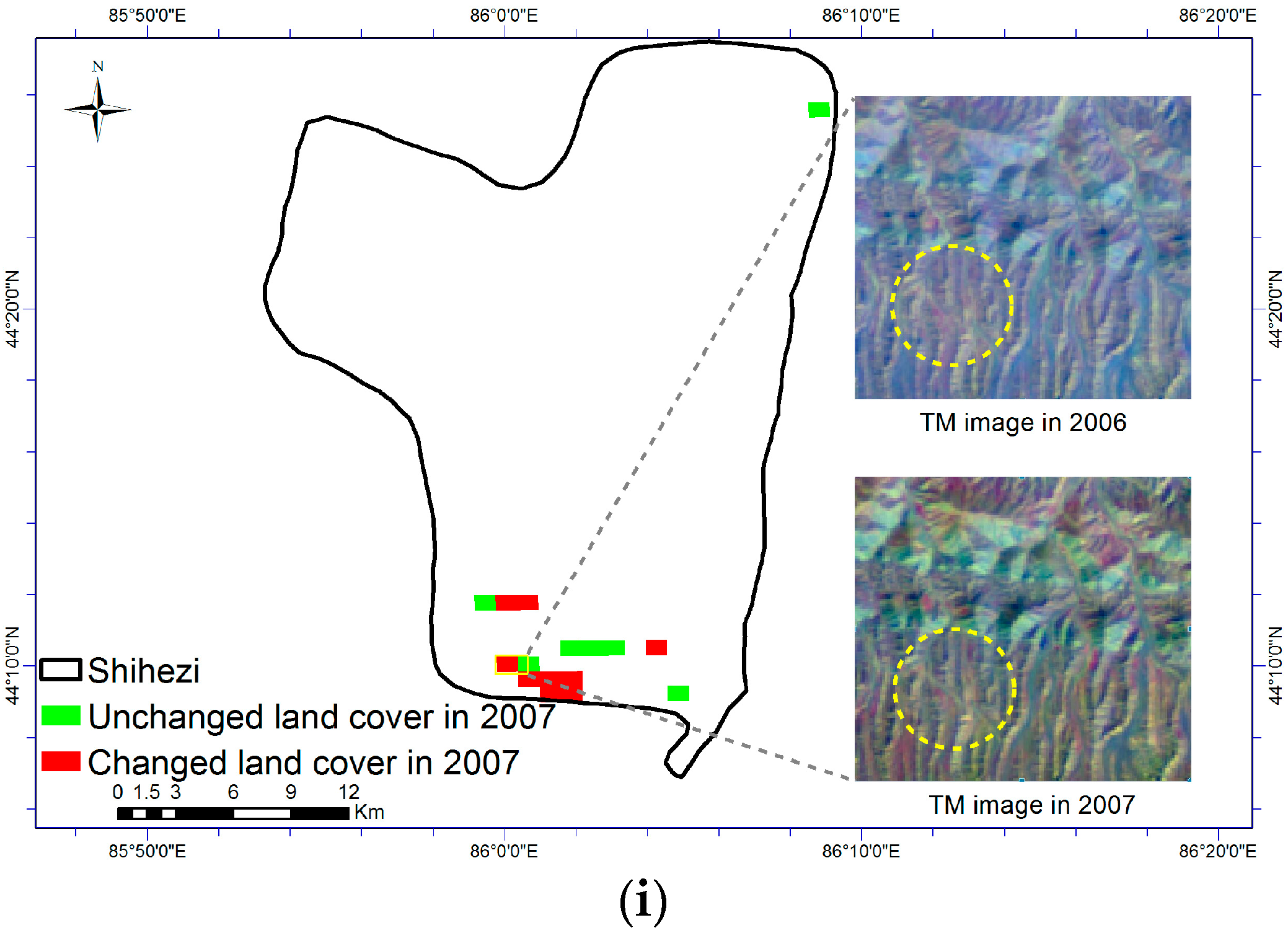

| Metropolitan | Slope | Metropolitan | Slope | Metropolitan | Slope | Metropolitan | Slope | Metropolitan | Slope |
|---|---|---|---|---|---|---|---|---|---|
| Chenzhou | 2.07 ** | Lanzhou | 0.54 * | Changsha | −0.27 | Nanjing | −0.06 | Xian | 0.06 |
| Dali | 3.95 *** | Lhasa | 3.65 *** | Dalian | −0.36 | Nanning | 0.65 * | Zhengzhou | −0.04 |
| Guilin | 1.65 ** | Shihezi | 0.03 | Fuzhou | 0.36 | Ningbo | 0.00 | Beijing | 0.56 *** |
| Guiyang | −0.41 | Taiyuan | 0.30 | Harbin | 0.52 | Qingdao | -0.03 | Chengdu | −0.07 |
| Haikou | 1.84 *** | Urumqi | 0.92 * | Hangzhou | −0.07 | Qiqihar | 3.76 *** | Chongqing | −0.20 |
| Heihe | 6.13 *** | Xiamen | −0.01 | Hefei | −0.47 | Shenyang | −0.04 | Guangzhou | −0.08 |
| Hohehot | 1.85 ** | Xining | 0.86 * | Jinan | −0.02 | Shijiazhuang | −0.03 | Shanghai | 0.00 |
| Jiuquan | 4.33 *** | Yinchuan | 0.77 ** | Kunming | 1.51 *** | Wuhan | 0.26 | Shenzhen | 0.00 |
| Kashgar | 4.48 *** | Changchun | 1.28 * | Nanchang | 0.06 | Wuxi | 0.02 | Tianjin | 0.00 |
| Year | GDP | Year | GDP | Year | GDP | ||||||
|---|---|---|---|---|---|---|---|---|---|---|---|
| IL | EL | R2 | IL | EL | R2 | IL | EL | R2 | |||
| 1993 | 1.02 *** | −0.06 *** | 0.59 | 2000 | 0.55 *** | −0.09 * | 0.71 | 2007 | 1.55 *** | −0.42 | 0.50 |
| 1994 | 0.30 *** | −0.01 | 0.78 | 2001 | 0.71 * | −0.18 | 0.38 | 2008 | 2.19 ** | −1.36 * | 0.37 |
| 1995 | 0.83 *** | −0.02 | 0.42 | 2002 | 0.59 *** | −0.06 | 0.51 | 2009 | −0.40 | −1.62 ** | 0.17 |
| 1996 | 1.76 * | −0.14 * | 0.25 | 2003 | 4.33 *** | −0.61 *** | 0.43 | 2010 | 1.09 *** | −0.39 | 0.44 |
| 1997 | 5.55 *** | −0.33 *** | 0.82 | 2004 | 1.34 *** | −0.19 * | 0.67 | 2011 | 6.59 *** | −1.80 * | 0.51 |
| 1998 | 1.19 *** | −0.05 | 0.47 | 2005 | 2.87 * | −0.20 | 0.30 | 2012 | 1.27 | −2.81 * | 0.20 |
| 1999 | 2.79 *** | −0.13 *** | 0.96 | 2006 | 2.17 *** | −0.28 | 0.52 | 2013 | 2.72 *** | −1.06 | 0.36 |
© 2017 by the authors. Licensee MDPI, Basel, Switzerland. This article is an open access article distributed under the terms and conditions of the Creative Commons Attribution (CC BY) license (http://creativecommons.org/licenses/by/4.0/).
Share and Cite
Jia, T.; Chen, K.; Wang, J. Characterizing the Growth Patterns of 45 Major Metropolitans in Mainland China Using DMSP/OLS Data. Remote Sens. 2017, 9, 571. https://doi.org/10.3390/rs9060571
Jia T, Chen K, Wang J. Characterizing the Growth Patterns of 45 Major Metropolitans in Mainland China Using DMSP/OLS Data. Remote Sensing. 2017; 9(6):571. https://doi.org/10.3390/rs9060571
Chicago/Turabian StyleJia, Tao, Kai Chen, and Jiye Wang. 2017. "Characterizing the Growth Patterns of 45 Major Metropolitans in Mainland China Using DMSP/OLS Data" Remote Sensing 9, no. 6: 571. https://doi.org/10.3390/rs9060571




